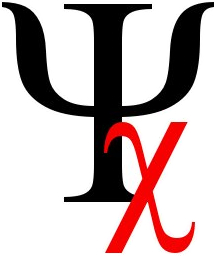© MCMLXXXVIII — MMXVIII
Speculative Grammarian™
A Tridecennial Celebration
A Letter from the
Editor-in-Chief
Astute readers will recognize the title of this missive as the copyright notice that—as of the year 2018—adorns the bottom of each page of the SpecGram website. For those who are too lazy or stupid to decode the Roman numerals (if you want to not be counted among the lazy and stupid, you can go decode the Roman numerals now; I’ll wait...), in mere Arabic numerals the notice reads “© 1988 — 2018”, making this year the tridecennial of that earliest copyright date.
|
|
 Fatih Bouguerra, 2013, De la grammaire du sens au sens de la grammaire: la grammaire négociée en lycée professionnel, Linguistique. Université Jean-Monnet-Saint-Étienne.
Fatih Bouguerra, 2013, De la grammaire du sens au sens de la grammaire: la grammaire négociée en lycée professionnel, Linguistique. Université Jean-Monnet-Saint-Étienne.
Chiasmus of the Month
November 2018
|
|
|
|
|
Conspiracy theorists—of which we have attracted more than our share—will try to tell you that SpecGram and/or a “precursor journal” was founded in 1988, rather than the widely accepted date of 1276 or the well-
supported but not quite universally accepted date of 881. Some cite the tale told in “The SpecGram Story”—a fictitious account found on pg. 319 of The Speculative Grammarian Essential Guide to Linguistics—which tells of the founding of Psammeticus Quarterly in 1988, of which SpecGram is a supposed lineal descendant. (For those too lazy or stupid to have purchased or otherwise procured a copy of The Essential Guide, “The SpecGram Story” is reportedly in the preview of the book available online.)
The so-called “modern era of SpecGram,” from which we have counted the CLXXXIII (i.e., “183”—innumerate heathens!) volumes of SpecGram on the cover of each issue goes back a mere 150 years, while the “thoroughly modern era of SpecGram” does in fact extend back only to 1988—hence our present tridecennial celebration!
Why 1988? Due to an error filing paperwork in the early 1920s, the copyright of SpecGram and associated journals only extends back to 1988 in several jurisdictions where our readership is most heavily concentrated—particularly Antarctica, Outer Mongolia, Ctesiphon, Venkatanarasimharajuvaripeta, and Kiviuq.
N.B.: Lingua Pranca and Son—published in 1978 and 1979, respectively—fall into the category of “previously unassociated” with SpecGram and are covered under a separate copyright, so don’t go getting any clever ideas.
The Great Botched Copyright, as it is known, was committed—of course—by a copyright intern... and the resultant floggings continue to this day!*
This thoroughly modern era can conveniently be split into two relatively equal time periods, the somewhat less modern Pre-Internet Era (PIE) from 1988 to 2003, and the slightly more modern and significantly more productive Internet Publication Age (IPA) from 2004 to 2018—see our Archives for full details.
A little-known fact about the PIE period is that a limited number of “second-string” copies of early thoroughly modern issues were mimeographed rather than photocopied. Originally, these second-string copies were distributed to reduced-rate subscribers—graduate students, independent scholars, sociolinguists, and other poverty-stricken linguists and linguistophiles. Printed on lower-quality paper, these mimeographed copies were not meant to last, and most did not. However, a few copies still exist, and are coveted by SpecGrammologists and other collectors of fine ephemera.

As the capstone of our tridecennial celebration, we have selected a random SpecGram subscriber to receive a set of five mimeographed issues of SpecGram and associated journals—collectively valued at over ZWL$25,000! The five issues are Psammeticus Quarterly XVI.1, Babel I.1, Linguist of Fortune—The Journal of the Linguistic Society of South-Central New Caledonia I.1, Speculative Grammarian CXLVII.1, and Collateral Descendant of Lingua Pranca.
N.B.: CDoLP is technically from the IPA era. As stated in its introduction, CDoLP is...
...obviously (onomastically speaking), not a direct descendant of the original Lingua Pranca and Son of Lingua Pranca anthologies. Instead it is a related-but-distinct entity: an homage (from the Early Middle French, meaning “rip-off”), a pastiche (from the Late Middle French, meaning “pile of refuse”), a parodie (from the Excluded Middle French, meaning “homage”).
However, an even-more-limited-than-was-traditional number of mimeographed copies were run off to celebrate CDoLP’s moldy old greatn-avuncular inspiration from the days of yore.
And the winner is.... Jerrold N. Fungellio! To all the others who didn’t even realize the contest was ongoing—thanks for playing!
It’s been quite a ride, but we’re still going strong!
*To forestall confusion on the part of the better informed yet less astute reader, “copyright” is what the head of the SG Copyright Scriptorium, the Copywright, secures by managing the interns in the Scriptorium, the Copywights,† who are appointed to office assigned desks and quills during the Copyrite. Thus, the contretemps-cum-foofaraw of the Great Botched Copyright must be rigorously distinguished from the Great Botched Copywright, the various Great Botched Copywights, Marks I–XVII, and the Great Botched Copyrite, all of which are tales we could tell in school except the last, about which all we will say is this: Do not put your Renaissance grimoires on the same shelf as your medieval herbals, because it turns out that the lexicolegal Powers That Be are generally allergic to oregano, and when they sneeze, look out!
† Please note for the sake of historical accuracy that this term has only been capitalized since c. 1990, when the introduction of computer technology meant that capitalizing the term did not entail excess ink costs, and thus a capital was installed in the term to improve intern morale or something.


